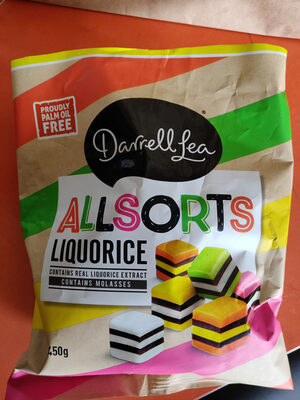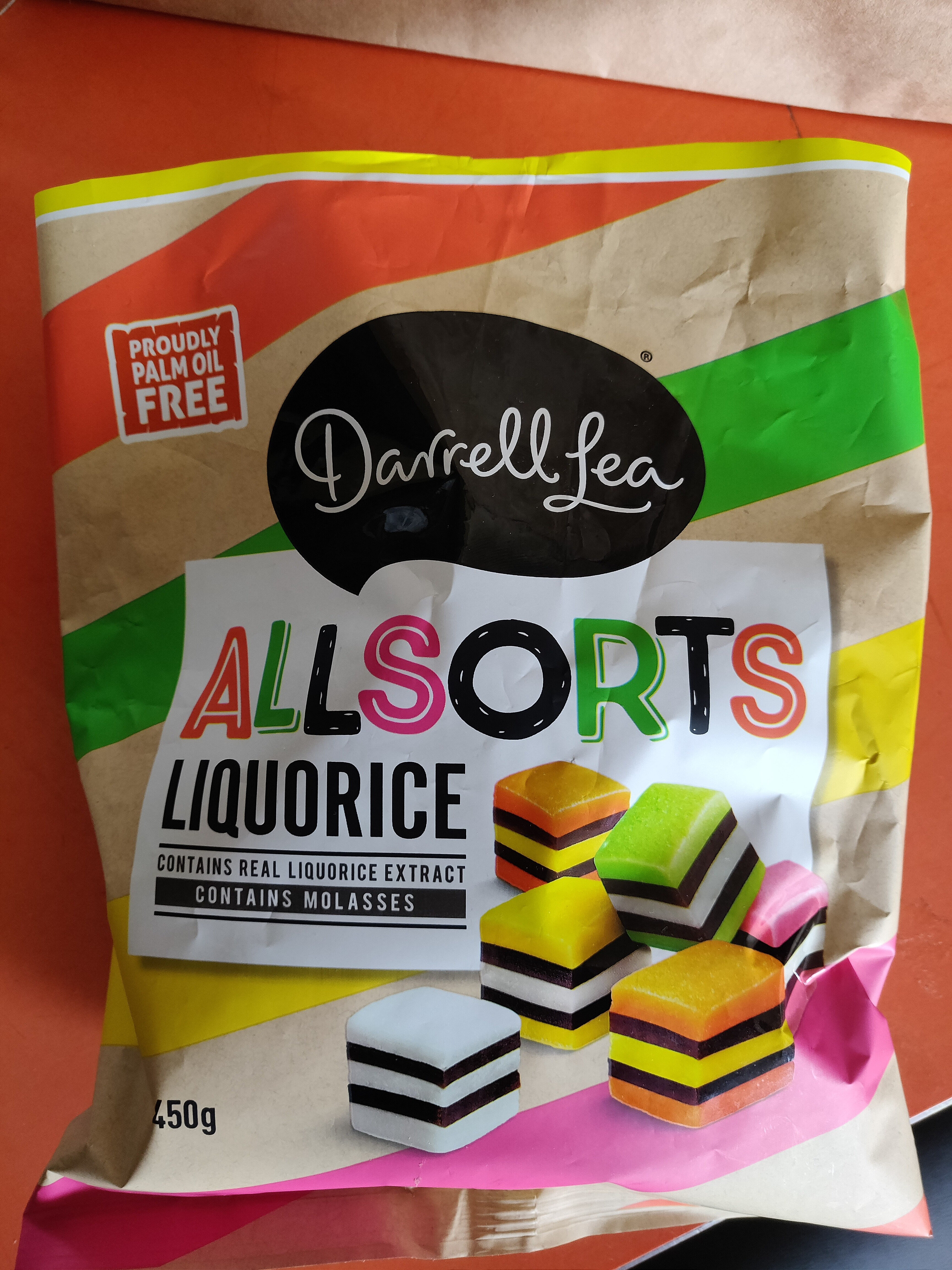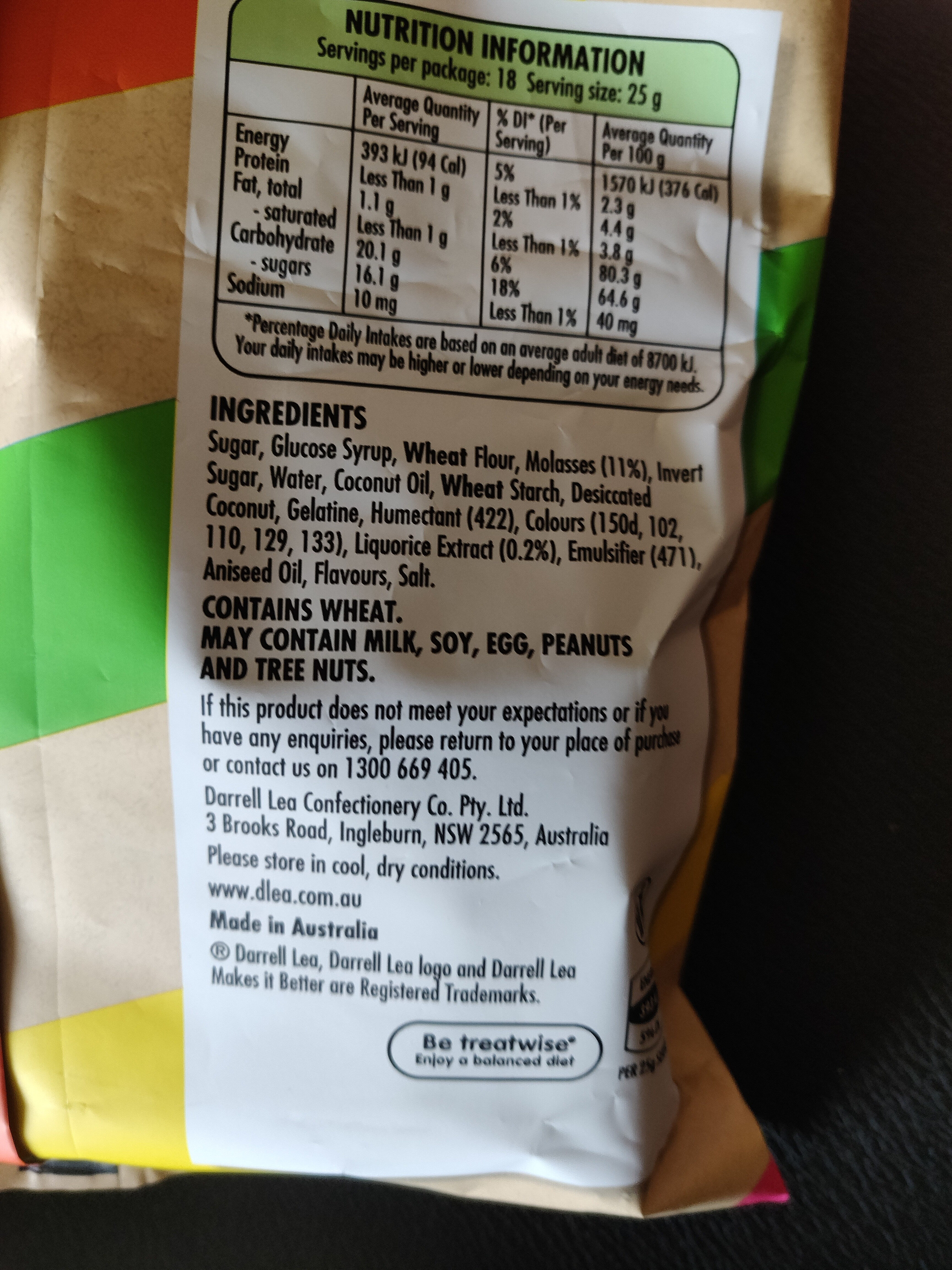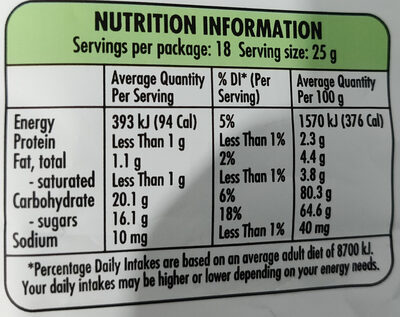Help us make food transparency the norm!
As a non-profit organization, we depend on your donations to continue informing consumers around the world about what they eat.
The food revolution starts with you!
Allsorts Liquorice - Darrell Lea - 450 g
Allsorts Liquorice - Darrell Lea - 450 g
This product page is not complete. You can help to complete it by editing it and adding more data from the photos we have, or by taking more photos using the app for Android or iPhone/iPad. Thank you!
×
Barcode: 9310881911793 (EAN / EAN-13)
Quantity: 450 g
Packaging: Plastic
Brands: Darrell Lea
Categories: Snacks, Sweet snacks, Confectioneries, Candies, Liquorice candies
Labels, certifications, awards: Australian made, No palm oil
Origin of ingredients: Australia
Stores: Woolworth's, Woolworths, Coles
Countries where sold: Australia
Matching with your preferences
Health
Ingredients
-
24 ingredients
Sugar, Glucose Syrup, Wheat Flour, Molasses (11%), Invert Sugar, Water, Coconut Oil, Wheat Starch, Desiccated Coconut, Gelatine, Humectant (422), Colours (150d, 102, 110, 129, 133), Liquorice Extract (0.2%), Emulsifier (471), Aniseed Oil, Flavours, Salt.Allergens: GlutenTraces: Eggs, Milk, Nuts, Peanuts, Soybeans
Food processing
-
Ultra processed foods
Elements that indicate the product is in the 4 - Ultra processed food and drink products group:
- Additive: E102 - Tartrazine
- Additive: E110 - Sunset yellow FCF
- Additive: E129 - Allura red
- Additive: E133 - Brilliant blue FCF
- Additive: E150d - Sulphite ammonia caramel
- Additive: E422 - Glycerol
- Additive: E428 - Gelatine
- Additive: E471 - Mono- and diglycerides of fatty acids
- Ingredient: Colour
- Ingredient: Emulsifier
- Ingredient: Flavouring
- Ingredient: Glucose
- Ingredient: Glucose syrup
- Ingredient: Humectant
- Ingredient: Invert sugar
Food products are classified into 4 groups according to their degree of processing:
- Unprocessed or minimally processed foods
- Processed culinary ingredients
- Processed foods
- Ultra processed foods
The determination of the group is based on the category of the product and on the ingredients it contains.
Additives
-
E102 - Tartrazine
Tartrazine: Tartrazine is a synthetic lemon yellow azo dye primarily used as a food coloring. It is also known as E number E102, C.I. 19140, FD&C Yellow 5, Acid Yellow 23, Food Yellow 4, and trisodium 1--4-sulfonatophenyl--4--4-sulfonatophenylazo--5-pyrazolone-3-carboxylate-.Tartrazine is a commonly used color all over the world, mainly for yellow, and can also be used with Brilliant Blue FCF -FD&C Blue 1, E133- or Green S -E142- to produce various green shades.Source: Wikipedia
-
E110 - Sunset yellow FCF
Sunset Yellow FCF: Sunset Yellow FCF -also known as Orange Yellow S, or C.I. 15985- is a petroleum-derived orange azo dye with a pH dependent maximum absorption at about 480 nm at pH 1 and 443 nm at pH 13 with a shoulder at 500 nm. When added to foods sold in the US it is known as FD&C Yellow 6; when sold in Europe, it is denoted by E Number E110.Source: Wikipedia
-
E129 - Allura red
Allura Red AC: Allura Red AC is a red azo dye that goes by several names, including FD&C Red 40. It is used as a food dye and has the E number E129. It is usually supplied as its red sodium salt, but can also be used as the calcium and potassium salts. These salts are soluble in water. In solution, its maximum absorbance lies at about 504 nm.Source: Wikipedia
-
E133 - Brilliant blue FCF
Brilliant Blue FCF: Brilliant Blue FCF -Blue 1- is an organic compound classified as a triarylmethane dye and a blue azo dye, reflecting its chemical structure. Known under various commercial names, it is a colorant for foods and other substances. It is denoted by E number E133 and has a color index of 42090. It has the appearance of a blue powder. It is soluble in water, and the solution has a maximum absorption at about 628 nanometers.Source: Wikipedia
-
E422 - Glycerol
Glycerol: Glycerol -; also called glycerine or glycerin; see spelling differences- is a simple polyol compound. It is a colorless, odorless, viscous liquid that is sweet-tasting and non-toxic. The glycerol backbone is found in all lipids known as triglycerides. It is widely used in the food industry as a sweetener and humectant and in pharmaceutical formulations. Glycerol has three hydroxyl groups that are responsible for its solubility in water and its hygroscopic nature.Source: Wikipedia
-
E471 - Mono- and diglycerides of fatty acids
Mono- and diglycerides of fatty acids (E471), are food additives commonly used as emulsifiers in various processed foods.
These compounds consist of glycerol molecules linked to one or two fatty acid chains, which help stabilize and blend water and oil-based ingredients. E471 enhances the texture and shelf life of products like margarine, baked goods, and ice cream, ensuring a smooth and consistent texture.
It is generally considered safe for consumption within established regulatory limits.
Ingredients analysis
-
Palm oil content unknown
Unrecognized ingredients: 422, 150d, 102, 110, 129, 133, 471Some ingredients could not be recognized.
We need your help!
You can help us recognize more ingredients and better analyze the list of ingredients for this product and others:
- Edit this product page to correct spelling mistakes in the ingredients list, and/or to remove ingredients in other languages and sentences that are not related to the ingredients.
- Add new entries, synonyms or translations to our multilingual lists of ingredients, ingredient processing methods, and labels.
If you would like to help, join the #ingredients channel on our Slack discussion space and/or learn about ingredients analysis on our wiki. Thank you!
-
Non-vegan
Non-vegan ingredients: E428Some ingredients could not be recognized.
We need your help!
You can help us recognize more ingredients and better analyze the list of ingredients for this product and others:
- Edit this product page to correct spelling mistakes in the ingredients list, and/or to remove ingredients in other languages and sentences that are not related to the ingredients.
- Add new entries, synonyms or translations to our multilingual lists of ingredients, ingredient processing methods, and labels.
If you would like to help, join the #ingredients channel on our Slack discussion space and/or learn about ingredients analysis on our wiki. Thank you!
-
Non-vegetarian
Non-vegetarian ingredients: E428Some ingredients could not be recognized.
We need your help!
You can help us recognize more ingredients and better analyze the list of ingredients for this product and others:
- Edit this product page to correct spelling mistakes in the ingredients list, and/or to remove ingredients in other languages and sentences that are not related to the ingredients.
- Add new entries, synonyms or translations to our multilingual lists of ingredients, ingredient processing methods, and labels.
If you would like to help, join the #ingredients channel on our Slack discussion space and/or learn about ingredients analysis on our wiki. Thank you!
-
Details of the analysis of the ingredients
We need your help!
Some ingredients could not be recognized.
We need your help!
You can help us recognize more ingredients and better analyze the list of ingredients for this product and others:
- Edit this product page to correct spelling mistakes in the ingredients list, and/or to remove ingredients in other languages and sentences that are not related to the ingredients.
- Add new entries, synonyms or translations to our multilingual lists of ingredients, ingredient processing methods, and labels.
If you would like to help, join the #ingredients channel on our Slack discussion space and/or learn about ingredients analysis on our wiki. Thank you!
: Sugar, Glucose Syrup, Wheat Flour, Molasses 11%, Invert Sugar, Water, Coconut Oil, Wheat Starch, Desiccated Coconut, Gelatine, Humectant (422), Colours (150d, 102, 110, 129, 133), Liquorice Extract 0.2%, Emulsifier (471), Aniseed Oil, Flavours, Salt- Sugar -> en:sugar - vegan: yes - vegetarian: yes - ciqual_proxy_food_code: 31016 - percent_min: 11 - percent_max: 65.2
- Glucose Syrup -> en:glucose-syrup - vegan: yes - vegetarian: yes - ciqual_proxy_food_code: 31016 - percent_min: 11 - percent_max: 38.1
- Wheat Flour -> en:wheat-flour - vegan: yes - vegetarian: yes - ciqual_proxy_food_code: 9410 - percent_min: 11 - percent_max: 29.0666666666667
- Molasses -> en:molasses - vegan: yes - vegetarian: yes - ciqual_proxy_food_code: 31016 - percent_min: 11 - percent: 11 - percent_max: 11
- Invert Sugar -> en:invert-sugar - percent_min: 0.2 - percent_max: 11
- Water -> en:water - vegan: yes - vegetarian: yes - ciqual_food_code: 18066 - percent_min: 0.2 - percent_max: 11
- Coconut Oil -> en:coconut-oil - vegan: yes - vegetarian: yes - from_palm_oil: no - ciqual_food_code: 16040 - percent_min: 0.2 - percent_max: 11
- Wheat Starch -> en:wheat-starch - vegan: yes - vegetarian: yes - ciqual_proxy_food_code: 9510 - percent_min: 0.2 - percent_max: 11
- Desiccated Coconut -> en:desiccated-coconut - vegan: yes - vegetarian: yes - ciqual_food_code: 15007 - percent_min: 0.2 - percent_max: 9.45714285714286
- Gelatine -> en:e428 - vegan: no - vegetarian: no - percent_min: 0.2 - percent_max: 8.25
- Humectant -> en:humectant - percent_min: 0.2 - percent_max: 7.31111111111111
- 422 -> en:422 - percent_min: 0.2 - percent_max: 7.31111111111111
- Colours -> en:colour - percent_min: 0.2 - percent_max: 6.56
- 150d -> en:150d - percent_min: 0 - percent_max: 6.56
- 102 -> en:102 - percent_min: 0 - percent_max: 3.28
- 110 -> en:110 - percent_min: 0 - percent_max: 2.18666666666667
- 129 -> en:129 - percent_min: 0 - percent_max: 1.64
- 133 -> en:133 - percent_min: 0 - percent_max: 1.312
- Liquorice Extract -> en:liquorice-extract - vegan: yes - vegetarian: yes - percent_min: 0.2 - percent: 0.2 - percent_max: 0.2
- Emulsifier -> en:emulsifier - percent_min: 0 - percent_max: 0.2
- 471 -> en:471 - percent_min: 0 - percent_max: 0.2
- Aniseed Oil -> en:aniseed-oil - from_palm_oil: no - percent_min: 0 - percent_max: 0.2
- Flavours -> en:flavouring - vegan: maybe - vegetarian: maybe - percent_min: 0 - percent_max: 0.2
- Salt -> en:salt - vegan: yes - vegetarian: yes - ciqual_food_code: 11058 - percent_min: 0 - percent_max: 0.01
Nutrition
-
Average nutritional quality
⚠ ️Warning: the amount of fiber is not specified, their possible positive contribution to the grade could not be taken into account.⚠ ️Warning: the amount of fruits, vegetables and nuts is not specified on the label, it was estimated from the list of ingredients: 0This product is not considered a beverage for the calculation of the Nutri-Score.
Positive points: 0
- Proteins: 0 / 5 (value: 1, rounded value: 1)
- Fiber: 0 / 5 (value: 0, rounded value: 0)
- Fruits, vegetables, nuts, and colza/walnut/olive oils: 0 / 5 (value: 0.203645833333339, rounded value: 0.2)
Negative points: 4
- Energy: 1 / 10 (value: 393, rounded value: 393)
- Sugars: 3 / 10 (value: 16.1, rounded value: 16.1)
- Saturated fat: 0 / 10 (value: 1, rounded value: 1)
- Sodium: 0 / 10 (value: 4, rounded value: 4)
The points for proteins are counted because the negative points are less than 11.
Nutritional score: (4 - 0)
Nutri-Score:
-
Nutrient levels
-
Fat in low quantity (1.1%)
What you need to know- A high consumption of fat, especially saturated fats, can raise cholesterol, which increases the risk of heart diseases.
Recommendation: Limit the consumption of fat and saturated fat- Choose products with lower fat and saturated fat content.
-
Saturated fat in low quantity (1%)
What you need to know- A high consumption of fat, especially saturated fats, can raise cholesterol, which increases the risk of heart diseases.
Recommendation: Limit the consumption of fat and saturated fat- Choose products with lower fat and saturated fat content.
-
Sugars in high quantity (16.1%)
What you need to know- A high consumption of sugar can cause weight gain and tooth decay. It also augments the risk of type 2 diabetes and cardio-vascular diseases.
Recommendation: Limit the consumption of sugar and sugary drinks- Sugary drinks (such as sodas, fruit beverages, and fruit juices and nectars) should be limited as much as possible (no more than 1 glass a day).
- Choose products with lower sugar content and reduce the consumption of products with added sugars.
-
Salt in low quantity (0.01%)
What you need to know- A high consumption of salt (or sodium) can cause raised blood pressure, which can increase the risk of heart disease and stroke.
- Many people who have high blood pressure do not know it, as there are often no symptoms.
- Most people consume too much salt (on average 9 to 12 grams per day), around twice the recommended maximum level of intake.
Recommendation: Limit the consumption of salt and salted food- Reduce the quantity of salt used when cooking, and don't salt again at the table.
- Limit the consumption of salty snacks and choose products with lower salt content.
-
-
Nutrition facts
Nutrition facts As sold
for 100 g / 100 mlAs sold
per serving (25g)Compared to: Candies Energy 393 kj
(94 kcal)98.2 kj
(23 kcal)-72% Fat 1.1 g 0.275 g -45% Saturated fat < 1 g < 0.25 g -40% Carbohydrates 20.1 g 5.03 g -75% Sugars 16.1 g 4.03 g -70% Fiber ? ? Proteins < 1 g < 0.25 g -63% Salt 0.01 g 0.002 g -94% Fruits‚ vegetables‚ nuts and rapeseed‚ walnut and olive oils (estimate from ingredients list analysis) 0.204 % 0.204 %
Environment
-
Eco-Score C - Moderate environmental impact
⚠ ️The full impact of transportation to your country is currently unknown.The Eco-Score is an experimental score that summarizes the environmental impacts of food products.→ The Eco-Score was initially developped for France and it is being extended to other European countries. The Eco-Score formula is subject to change as it is regularly improved to make it more precise and better suited to each country.Life cycle analysis
-
Average impact of products of the same category: B (Score: 62/100)
Category: Candies, all types
Category: Candies, all types
- PEF environmental score: 0.41 (the lower the score, the lower the impact)
- including impact on climate change: 1.73 kg CO2 eq/kg of product
Stage Impact Agriculture
78.2 %Processing
10.7 %Packaging
5.5 %Transportation
4.5 %Distribution
1.1 %Consumption
0.0 %
Bonuses and maluses
-
Origins of ingredients with a high impact
Malus:
Environmental policy: +3
Transportation: 0
Origin of the product and/or its ingredients % of ingredients Impact Australia 100 %Medium
-
Packaging with a medium impact
Malus: -10
Shape Material Recycling Impact Unknown Plastic High ⚠ ️ The information about the packaging of this product is not sufficiently precise (exact shapes and materials of all components of the packaging).⚠ ️ For a more precise calculation of the Eco-Score, you can modify the product page and add them.
If you are the manufacturer of this product, you can send us the information with our free platform for producers.
Eco-Score for this product
-
Impact for this product: C (Score: 55/100)
Product: Allsorts Liquorice - Darrell Lea - 450 g
Life cycle analysis score: 62
Sum of bonuses and maluses: -10
Final score: 55/100
-
Carbon footprint
-
Equal to driving 0.9 km in a petrol car
173 g CO² per 100g of product
The carbon emission figure comes from ADEME's Agribalyse database, for the category: Candies, all types (Source: ADEME Agribalyse Database)
Stage Impact Agriculture
52.3 %Processing
19.5 %Packaging
15.7 %Transportation
11.6 %Distribution
1.0 %Consumption
0.0 %
Packaging
-
Packaging with a medium impact
-
Packaging parts
(Plastic)
-
Packaging materials
Material % Packaging weight Packaging weight per 100 g of product Plastic
-
Transportation
-
Origins of ingredients
Origins of ingredients with a high impact
Origin of the product and/or its ingredients % of ingredients Impact Australia 100 %Medium
Report a problem
-
Incomplete or incorrect information?
Category, labels, ingredients, allergens, nutritional information, photos etc.
If the information does not match the information on the packaging, please complete or correct it. Open Food Facts is a collaborative database, and every contribution is useful for all.
Data sources
Product added on by llahsivk
Last edit of product page on by roboto-app.
Product page also edited by archanox, ecoscore-impact-estimator, openfoodfacts-contributors, packbot, teolemon.










